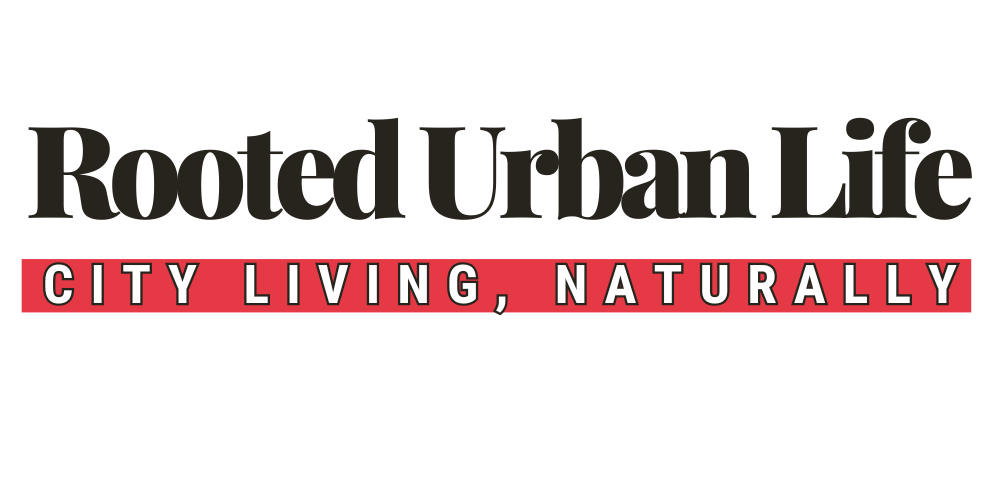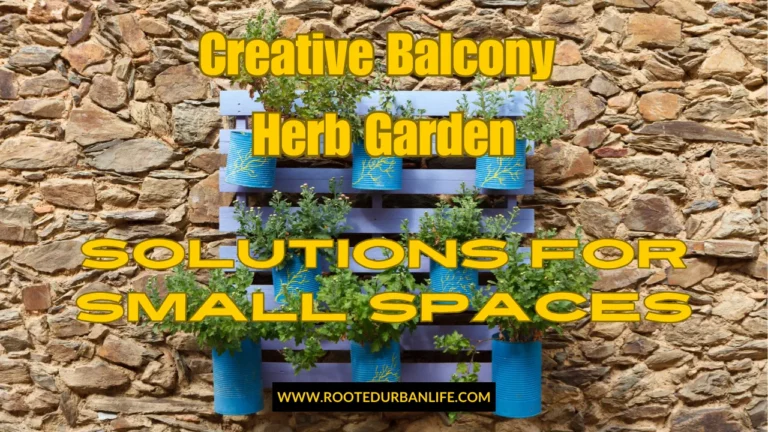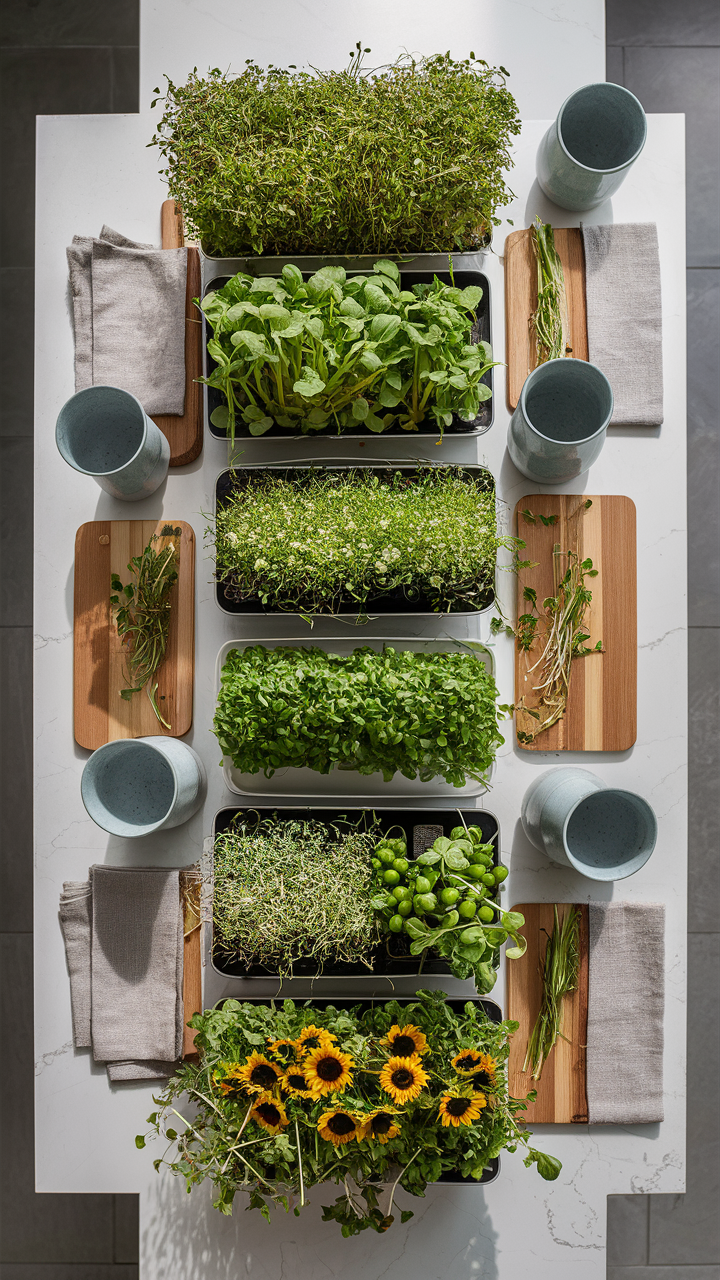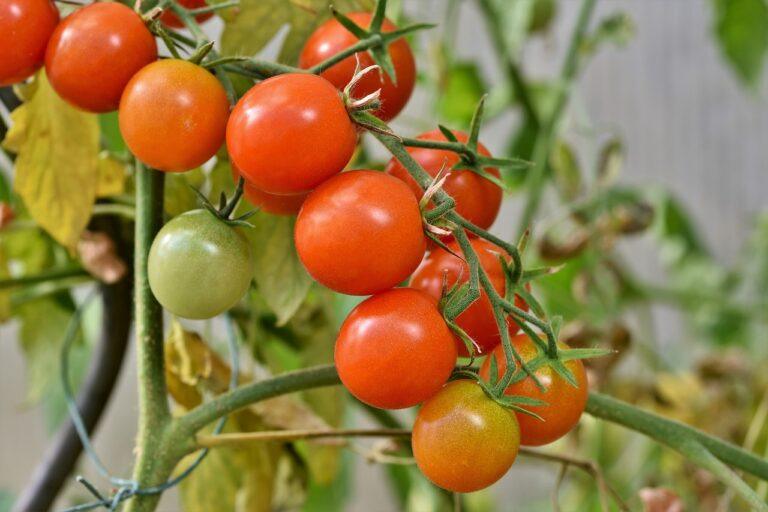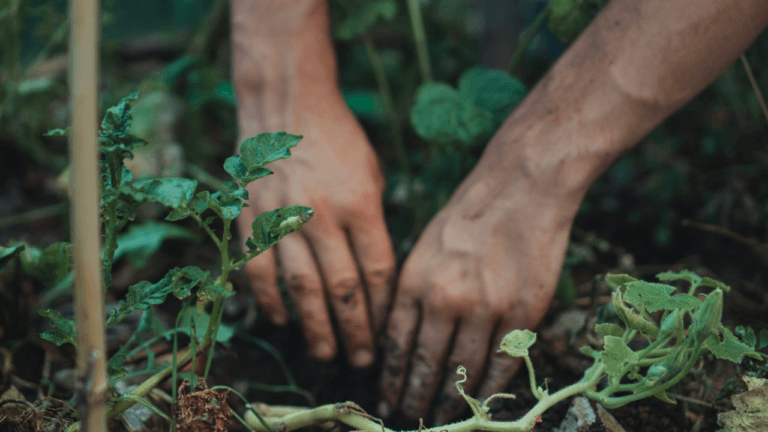9 Essential Space-Saving Ideas for Urban Gardeners
If you’re looking for the best urban gardening techniques to make the most of your small space, you’re in the right place.
These space-saving techniques can help you transform even the smallest of spaces into a flourishing garden.
Mastering these techniques is easier than you might think.
Whether you have a tiny 3×5 foot balcony, just a sunny 2-foot wide windowsill, or even no outdoor space at all, there’s a gardening solution for you.
Essential Space-Saving Ideas for Urban Gardeners
| We’ll explore nine innovative urban gardening techniques for space-constrained environments: container gardening, vertical gardening, hydroponics, aquaponics, community gardening, rooftop gardening, container gardening, window box gardening, indoor microgreens, keyhole gardening. |
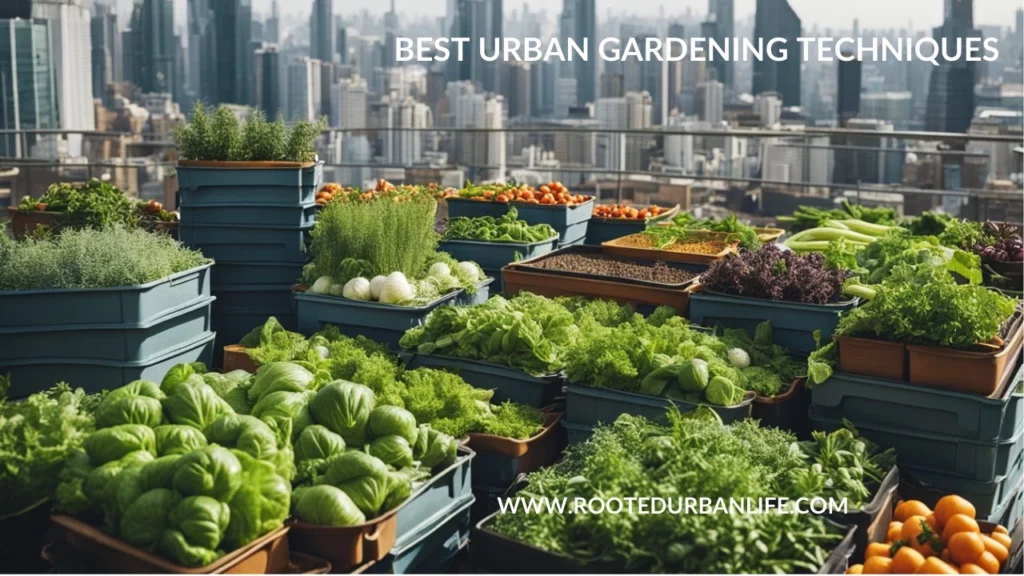
Container Gardening: Versatility in Small Spaces
Container gardening, a technique dating back to ancient Egypt, remains a flexible option for space-constrained gardeners.
This method allows you to cultivate a variety of plants, from aromatic herbs to juicy tomatoes, in virtually any urban setting.
Key benefits:
- Adaptability to various spaces (balconies, patios, windowsills)
- Easy to move and rearrange
- Allows for creative repurposing of household items
Getting Started:
- Choose the right container: Ensure it has drainage holes and is appropriately sized for your chosen plants.
- Select a high-quality potting mix designed for container gardening.
- Pick plants suitable for container growth, such as herbs, lettuce, or dwarf fruit trees.
Pro Tip: Try growing compact varieties like ‘Patio Princess’ tomatoes or ‘Spacemaster’ cucumbers, which are specifically bred for small spaces.
Concerned about costs? Container gardening can be very budget-friendly.
You can even repurpose household items like buckets or wooden crates as planters.
Vertical Gardening: Save Space By Growing up
Vertical gardening is a game-changer for maximizing your growing area without sacrificing precious floor space.
This innovative technique allows you to transform walls, fences, and other vertical surfaces into lush, productive gardens.
Key Benefits:
- Maximizes limited space
- Improves air circulation, reducing plant diseases
- Adds visual interest and can act as natural insulation
Getting Started:
- Choose a sturdy structure: Use trellises, wall-mounted planters, or repurposed items like pallets.
- Select appropriate plants: Opt for vining vegetables (peas, beans), trailing herbs (thyme, oregano), or cascading flowers (petunias).
- Ensure proper watering: Consider a drip irrigation system for even water distribution.
Pro Tip: Create a “green wall” using a variety of plants with different textures and colors.
Try combining edible plants like strawberries with ornamental flowers for a beautiful and functional display.
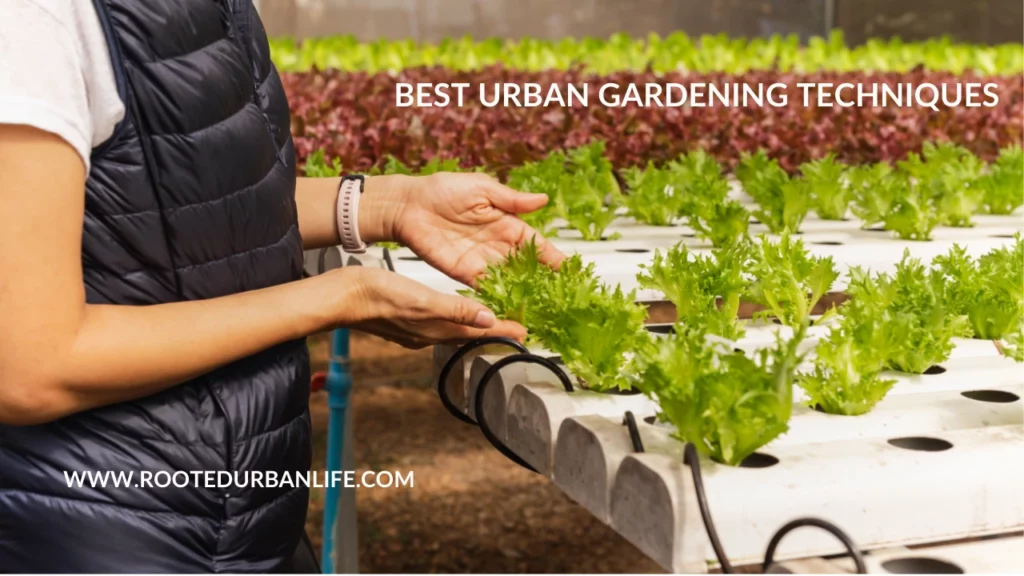
Hydroponics: Efficient Gardening, No Soil Needed
Hydroponics offers a high-tech, soil-free solution perfect for indoor spaces or areas with poor soil quality.
This method involves growing plants in a nutrient-rich water solution, allowing for year-round cultivation regardless of outdoor conditions.
Key Benefits:
- Uses up to 90% less water than traditional gardening
- Accelerated plant growth and higher yields
- Can be done indoors, allowing for year-round growing
Getting Started:
- Choose a hydroponic system: Options include Nutrient Film Technique (NFT), Deep Water Culture (DWC), or the beginner-friendly Kratky method.
- Select appropriate plants: Leafy greens, herbs, and fruiting plants like tomatoes and peppers thrive in hydroponic systems.
- Maintain proper nutrient and pH levels for optimal growth.
While the initial setup might seem complex, many affordable and user-friendly hydroponic kits are available for beginners.
Step-by-Step Guide to Monitoring Hydroponic Systems:
- Invest in a digital pH meter and EC (Electrical Conductivity) meter.
- Test pH levels daily to determine imbalances. The optimal pH levels depend on the plants that you grow.
- Check EC levels weekly, nd adjust it either by increasing the nutrients or by adding more water.
- Adjust levels using pH Up/Down solutions and nutrient concentrates as needed.
Pro Tip: Start with a small, simple system like the Kratky method for herbs before scaling up to more complex setups.
Community Gardening: Cultivating Connections
Community gardening is a collaborative approach that not only provides space for growing but also fosters social connections and contributes to local food security.
This method is perfect for those who lack private outdoor space but still want to experience the joys of gardening.
Key benefits:
- Access to larger growing spaces
- Opportunity to learn from experienced gardeners
- Strengthens community bonds
- Contributes to local food security
Getting Started:
- Locate a community garden near you or start one with neighbors.
- Attend garden meetings and volunteer for shared tasks.
- Start with easy-to-grow crops like tomatoes, zucchini, or leafy greens.
If you’re worried about the time commitment, community gardens often allow you to share responsibilities with other gardeners, making it more manageable.
Community Garden Plot Management Tips:
- Create a planting calendar to maximize your plot’s productivity throughout the season.
- Implement crop rotation to maintain soil health and prevent pest build-up.
- Participate in communal composting to improve soil quality and reduce waste.
Rooftop Gardening: A Top Urban Gardening Technique for Creating New Green Spaces
Rooftop gardening utilizes often-overlooked spaces to create productive green areas in the heart of the city.
This technique not only maximizes growing space but also offers significant environmental and economic benefits.
Key benefits:
- Utilizes unused urban space
- Improves building insulation and reduces energy costs
- Mitigates urban heat island effect
- Manages stormwater runoff
Getting Started:
- Ensure your roof can support the added weight of a garden.
- Choose lightweight containers and appropriate soil mix.
- Select plants that can tolerate wind and sun exposure.
Environmental impact:
Green roof provide additional insulation which helps reduce the heating costs. They also help reduce the urban heat island effect by lowering the temperature.
Best Plants for Rooftop Gardens in Cities:
- Drought-tolerant succulents like sedum and hens-and-chicks
- Hardy herbs such as rosemary, thyme, and lavender
- Native wildflowers to support local pollinators
- Dwarf fruit trees in large containers
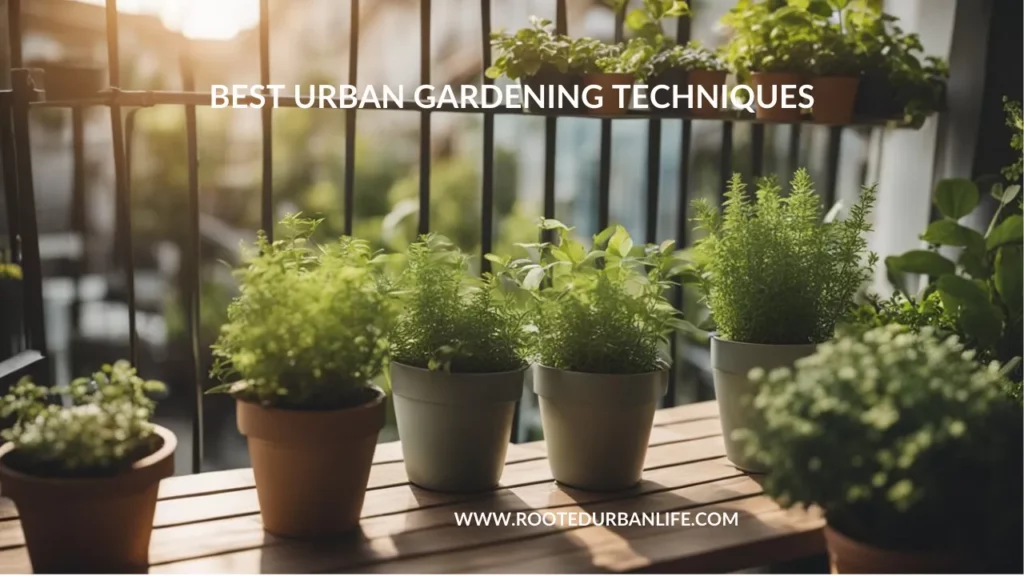
Window Box Gardening: Smart Solutions for Small Urban Spaces
Window box gardening is perfect for those with minimal space, allowing you to grow plants right on your windowsill or balcony railing.
Key Benefits:
- Requires very little space
- Adds beauty to your home’s exterior
- Ideal for herbs and small flowering plants
Getting Started:
- Choose a sturdy window box with proper drainage
- Select plants that match your window’s sun exposure
- Use a high-quality potting mix
- Water regularly, as window boxes can dry out quickly
Pro Tip: Try growing a mix of herbs like basil, chives, and parsley for a convenient kitchen herb garden.
Indoor Microgreens: Nutrient-Dense Greens in Tiny Spaces
Microgreens are young vegetable greens that are packed with nutrients and flavor.
Key Benefits:
- Requires minimal space and equipment
- Harvest within 1-2 weeks of planting
- Highly nutritious
Getting Started:
- Choose a shallow tray with drainage holes
- Use a seed-starting mix or coconut coir
- Sprinkle seeds densely over the soil
- Cover with a thin layer of soil and mist regularly
Pro Tip: Try growing microgreens from radish, arugula, or sunflower seeds for a spicy, nutty flavor mix.
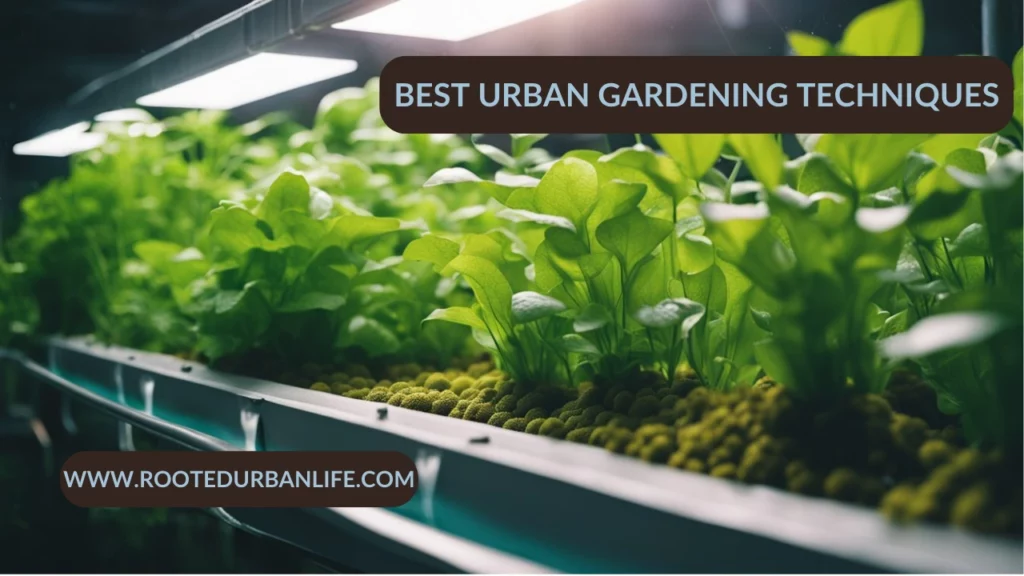
Aquaponics: Sustainable Ecosystem in Your Home
Aquaponics combines raising fish with growing plants in a symbiotic environment.
Key Benefits:
- Water-efficient
- Produces both plants and fish
- Can be scaled to fit different spaces
Getting Started:
- Set up a fish tank and a separate grow bed
- Choose fish suitable for aquaponics (e.g., tilapia, goldfish)
- Select plants that thrive in water-rich environments
- Install a pump to circulate water between the fish tank and grow bed
Pro Tip: Start with hardy plants like lettuce or herbs while you’re learning to balance the system
Keyhole Gardening: Water-Efficient Raised Beds
Keyhole gardens are raised circular beds with a central compost basket, designed for water efficiency.
Key Benefits:
- Conserves water
- Continually nourishes soil through central composting
- Good option for areas with poor soil
Getting Started:
- Build a circular raised bed with a “keyhole” entrance
- Create a central composting basket
- Fill the bed with layers of organic material and soil
- Plant your vegetables around the outer edge
Pro Tip: This method works great for plants with high nutrient needs, like tomatoes or leafy greens
Comparison of Urban Gardening Techniques
Urban Gardening Techniques Comparison
| Technique | Space Required | Maintenance Level | Water Usage | Yield Potential | Startup Costs | Best For |
|---|---|---|---|---|---|---|
| Container Gardening | Minimal | Low-Medium | Medium | Medium | $50-$200 | Balconies, Patios, Beginners |
| Vertical Gardening | Small-Medium | Medium | Low-Medium | High | $100-$300 | Walls, Fences, Space Savers |
| Hydroponics | Small | High | Low | Very High | $200-$500 | Indoors, Tech Enthusiasts |
| Community Gardening | Shared | Medium | Medium | Medium | $50-$100 | Social Gardeners, Beginners |
| ️ Rooftop Gardening | Large | High | Medium-High | High | $500-$2000+ | Buildings with roof access |
| Window Box Gardening | Minimal | Low | Low-Medium | Low-Medium | $30-$100 | Apartment Dwellers, Beginners |
| Indoor Microgreens | Minimal | Low | Low | Medium | $20-$50 | Health Enthusiasts, Quick Results |
| Aquaponics | Medium | High | Low | High | $300-$1000 | Sustainable Living Enthusiasts |
| Keyhole Gardening | Small-Medium | Low | Low | Medium-High | $100-$300 | Water Conservation, Composters |
Brought to You by Rooted Urban Life (https://rootedurbanlife.com)
Getting Started: Your First Urban Garden
Ready to start your urban gardening journey? Follow these steps to create your own green space:
- Assess your space and sunlight conditions.
- Choose the technique(s) best suited to your situation.
- Start small with easy-to-grow plants like herbs or lettuce.
- Invest in quality soil, containers, or hydroponic equipment.
- Set up a watering schedule and stick to it.
- Monitor your plants regularly for pests or nutrient deficiencies.
- Harvest and enjoy your homegrown produce!
Frequently Asked Questions
Q: I don’t have a green thumb. Can I really grow plants in an urban environment?
A: Absolutely! Many urban gardening techniques are beginner-friendly.
Start small with hardy plants like herbs or lettuce. Remember, every expert gardener started as a beginner.
With patience and practice, you’ll develop your gardening skills over time.
Q: Isn’t urban gardening expensive to start?
A: While there can be some upfront costs, urban gardening doesn’t have to be expensive.
Start with affordable methods like container gardening or window boxes.
You can even repurpose household items as planters to save money.
The long-term savings on fresh produce often outweigh the initial investment.
Q: I’m worried about using chemicals in my small living space. Is urban gardening safe?
A: Urban gardening can be very safe and chemical-free.
Many urban gardeners practice organic gardening methods.
You can use natural pest control methods and organic fertilizers to ensure your garden is safe for your living space.
Q: I live in an apartment with no outdoor space. Can I still garden?
A: Definitely! Indoor gardening methods like microgreens, hydroponics, or simple potted herbs on a sunny windowsill are great options for apartment dwellers with no outdoor space.
Q: I’m concerned about the time commitment. How much time does urban gardening require?
A: The time commitment can vary based on the method and scale of your garden.
However, many urban gardening techniques are designed to be low-maintenance.
Container gardens or window boxes, for instance, might only require a few minutes of care each day.
You can always start small and expand as you become more comfortable.
Q: I’m renting. Won’t gardening damage the property?
A: Many urban gardening methods are renter-friendly and won’t cause damage.
Container gardening, for instance, is portable and doesn’t affect the property.
Always check with your landlord, and consider methods that don’t require permanent installations.
Q: What if I can’t grow enough to make a difference in my food supply?
A: Even a small garden can make a difference!
While you might not be able to grow all your own food, having fresh herbs or a few homegrown vegetables can enhance your meals and reduce your grocery bill.
Plus, the satisfaction of growing your own food, regardless of the quantity, is immeasurable.
Remember, urban gardening is about more than just food production.
It’s a way to connect with nature, reduce stress, and create a greener living space.
Don’t let concerns hold you back – start small, learn as you go, and enjoy the process!
Key Takeaways
| Urban gardening is accessible to everyone, regardless of space constraints or experience level. Container and vertical gardening are versatile techniques suitable for most urban environments. Hydroponic and aquaponic systems offer high-yield, water-efficient options for indoor gardening. Community gardens provide social benefits alongside opportunities for larger-scale growing. Rooftop and balcony gardens can significantly impact building energy efficiency and urban heat reduction. Even the smallest spaces, like windowsills, can be productive growing areas for herbs and microgreens. Many urban gardening techniques are low-maintenance and beginner-friendly. Urban gardening contributes to sustainability, improved air quality, and local food security. Starting small and gradually expanding is a practical approach for new urban gardeners. The benefits of urban gardening extend beyond food production to include stress reduction and connection with nature. |
Urban gardening offers endless possibilities to create a successful and productive garden in the heart of the city.
By embracing these nine techniques—container gardening, vertical gardening, hydroponics, community gardens, rooftop gardening, window box gardening, indoor microgreens, aquaponics, and keyhole gardening—you can transform any urban space into a thriving green oasis.
Whether you’re growing fresh herbs for your kitchen, cultivating flowers for beauty, or building a community garden, these methods provide the foundation for a successful gardening experience.
Start by choosing the method that suits your space and lifestyle best, and don’t be afraid to experiment.
Remember, every expert gardener started as a beginner, so be patient with yourself and enjoy the learning process.
We’d love to hear about your urban gardening adventures!
Share your experiences, challenges, and successes in the comments below.
And don’t forget to subscribe to our newsletter for more homesteading tips and urban gardening insights delivered straight to your inbox.

